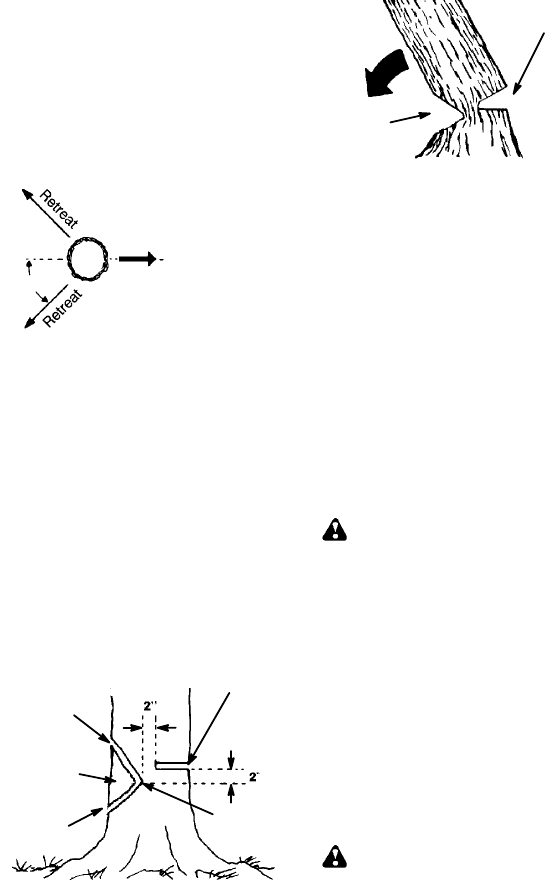
12
S The wind direction and speed.
S The lean of the tree. The lean of a tree
might not be apparent due to uneven or
sloping terrain. Usea plumbor level tode-
termine the direction of tree lea n.
S Weight and branches on one side.
S Surrounding trees and obstacles.
Look for decay and rot. If thetrunk is rotted,
it can snap and fall toward the operator.
Check for broken or dead branches which
can fall on you while cutting.
Make sure there is enough room for the tree to
fall. Maintain a distance of
2-1/2 tre e lengths
from the nearest person or other objects. En-
gine noise can drown out a warning call.
Remove dirt, stones, loose bark, nails, sta-
ples, andwire fromthe treewherecuts areto
bemade. Plan aclearretreat pathto therear
and diagonal to the line of fall.
Direction of Fall
45_
Plan a clear retreat path
FELLING LARGE TREES
(6 inches (15 cm) in diameter or larger)
The notch method is used to fell large trees.
Anotchis cut onthe sideofthe treein thede-
sired direction of fall. After a felling cut is
made on the opposite side of tree, the tree
will tend to fall into the notch.
NOTE: If the tree has large buttress roots,
removethem beforemakingthenotch. If us-
ing saw to remove buttress roots, keep saw
chain fromcontactinggroundto preventdull-
ing of the chain.
NOTCH CUT AND FELLING THE
TREE
S Make notch cut by cutting the top of the
notch first. Cut through
1/3 of the diameter
ofthetree.Nextcompletethenotchbycut-
ting the bottom of the notch. See illustra-
tion. Once the notch is cut remove t he
notch of wood from the tree.
Notch
First cut
Second cut
Final (felling) cut here, 2 inches
(5 cm) above center of notch.
Hinge
S After removing the wood from the notch,
make the felling cut on the opposite side of
thenotch. Thisis doneby makinga cut about
two inches (5 cm) higher than the center of
the notch. This willleaveenough uncut wood
between the felling cut and the notch to form
a hinge. This hinge will help prevent the tree
from falling in the wrong direction.
Opening
of felling
cut
Closing of
notch
Hinge holds tree on stump and helps
control fall
NOTE: Before felling cut is complete, use
wedges to open the cut if necessary to
controlthedirectionoffall. To avoidkickback
and chain damage, use wood or plastic
wedges, but never steel or iron wedges.
S Be alert to signs that the tree is ready to
fall: cracking sounds, widening of the fell-
ing cut, or movement in the upper
branches.
S As tree starts to fall, stop saw, put it down,
and get away quickly on your planned re-
treat path.
S DO NOT cut down a part ially fallen tree
with your saw. Beextremely cautious with
partially fallen trees that may be poorly
supported. When a tree doesn’t fall com-
pletely,setthesawasideandpull downthe
tree with a cable winch, block and tackle,
or tractor.
CUTTING A FALLEN TREE
(BUCKING)
Bucking is the term used for cutting a fallen
tree to the desired log size.
WARNING: Do not stand on the log
being cut. Any portion can roll causing loss
of footing and control. Do not stand downhill
of the log being cut.
IMPORTANT POINTS
S Cut only one log at a time.
S Cut shattered w ood very carefully; sharp
pieces of wood could be flung toward opera-
tor .
S Use a sawhorse to cut small logs. Never
allow another person to hold the log while
cutting andnever holdthe logwith yourleg
or foot.
S Do not cut in an area where logs, limbs,
and roots are tangled such as in a blown
down area. Drag thelogs intoa clear area
before cutting by pulling out exposed and
cleared logs first.
TYPES OF CUTTING USED FOR
BUCKING
WARNING: If sawbecomespinched
or hung in a log, don’t try to force it out. You
can lose control of thesaw resulting in injury
and/or damage to the saw. Stop the saw,
drive a wedge of plastic or wood into the cut


















